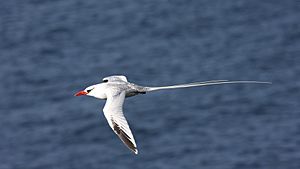Phaethontiformes facts for kids
Quick facts for kids Phaethontiformes |
|
|---|---|
 |
|
| Red-billed tropicbird | |
| Scientific classification |
|
| Kingdom: | Animalia |
| Phylum: | Chordata |
| Class: | Aves |
| Clade: | Eurypygimorphae |
| Order: | Phaethontiformes Sharpe, 1891 |
| Families | |
|
|
The Phaethontiformes are an order of birds. This group includes the tropicbirds, which are the only family still alive today (Phaethontidae). It also includes an extinct family called Prophaethontidae, which lived a long time ago.
Scientists have found many fossils of these birds. Some of the oldest and best-preserved fossils are from the Paleocene epoch. This was a time period that started about 66 million years ago. It's possible that this bird group is even older. An ancient waterbird called Novacaesareala, found in New Jersey, might be an early tropicbird. This bird lived around the very end of the Cretaceous period or the start of the Paleocene.
Contents
What Are Phaethontiformes?
Phaethontiformes are a group of birds that includes tropicbirds. Tropicbirds are known for their long tail feathers and their ability to fly over open oceans. They are often found in tropical parts of the world.
Ancient History of Phaethontiformes
Many fossils of Phaethontiformes have been found from the Paleocene and Eocene epochs. The Eocene epoch followed the Paleocene, ending about 34 million years ago.
After the Oligocene epoch, which ended about 23 million years ago, fewer fossils of these birds are found. This suggests that around that time, these birds might have moved away from coastal areas. They likely started living more in the open ocean, far from land. This "pelagic" (open ocean) lifestyle is still seen in the tropicbirds alive today. Birds that live far out at sea are harder to fossilize.
How Scientists Classify Birds
For a long time, tropicbirds were grouped with other water birds. These included pelicans, cormorants, darters, gannets and boobies, and frigatebirds. All these birds were part of an order called Pelecaniformes.
Later, a different way of classifying birds, called the Sibley-Ahlquist taxonomy, put Pelecaniformes with even more groups. This created a very large group called "Ciconiiformes."
However, scientists later found that these large groupings were not quite right. They realized that some of the birds in these groups were not as closely related as once thought. So, the groups were split up again.
In 1995, a scientist named Konstantin Mikhailov studied the tiny structures of bird eggshells. He found that tropicbird eggshells were different from those of other birds in the Pelecaniformes group. This difference helped show that tropicbirds might belong in their own separate group.
Modern Bird Family Tree
Early studies in the last ten years suggested that Phaethontiformes might be distantly related to another group called Procellariiformes. This group includes albatrosses and petrels.
However, since 2004, most new studies using molecular biology (looking at DNA) have placed Phaethontiformes differently. These studies suggest they are not closely related to Procellariiformes.
A big study in 2014 by Jarvis and others looked at the full DNA of many modern birds. This study helped to map out the "tree of life" for birds. It showed that Phaethontiformes are most closely related to the sunbittern and the kagu. These two birds are part of the Eurypygiformes group.
These three groups (Phaethontiformes, sunbitterns, and kagus) together form a "sister group" to the "core water birds." The "core water birds" are a large group called the Aequornithes. This new understanding means that older ideas about bird relationships have been changed.

